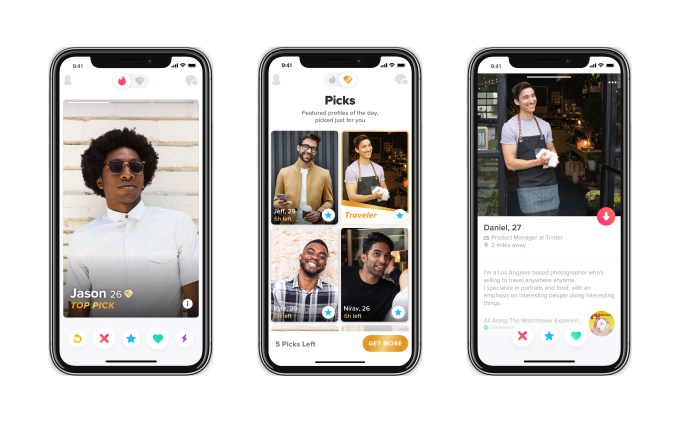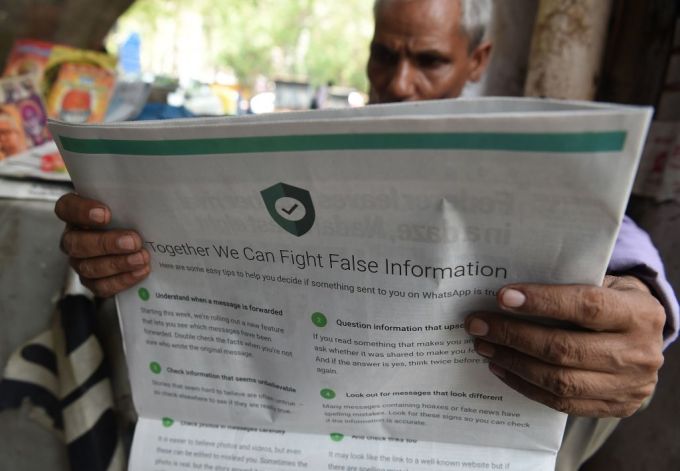Apps
Auto Added by WPeMatico
Auto Added by WPeMatico
Even if you don’t plan on buying a new iPhone, you’ll be able to get a bunch of new features next week. Apple plans on releasing iOS 12, the next major version of iOS, on Tuesday, September 17th.
As always, iOS 12 will be available as a free download. If your iPhone or iPad runs iOS 11, you’ll be able to update to iOS 12 as Apple plans to keep supporting all existing iOS 11 devices.
Here’s a quick rundown of what’s new in iOS 12. The main feature of iOS 12 is a performance improvement, especially for older devices. If you have an iPhone 6 or an iPad Air for instance, you should see a big improvement when it comes to launching apps, triggering the camera and entering text.
The other big theme of the year is new features to help you spend less time using your phone. There’s a new Screen Time feature to see and control how much time you spend using each app. Notifications are now grouped and you can silence them from the lock screen. You also can turn on Do Not Disturb when you’re in a meeting, for a few hours or for longer.
Apple didn’t stop there, and added new power features as well. Developers will be able to take advantage of a new file format for augmented reality and new features in ARKit 2.0. Apple is releasing the Workflow app as a new Siri Shortcuts app. Developers will be able to add information to Siri, as well, so that you can add a boarding pass or a music playlist to Siri.
The Photos, News and Stocks apps have been improved, as well as Apple Books (the app formerly known as iBooks). Apple is introducing Memoji on the iPhone X. It’s a customized avatar that you can use in iMessage and FaceTime to represent you.
If you want to learn more, read my iOS 12 preview to get my thoughts on this update.
Powered by WPeMatico
Apple just unveiled brand new phones. The iPhone XS and XS Max are the two new flagship devices, replacing the iPhone X. The iPhone XR is replacing the iPhone 8 and iPhone 8 Plus with Face ID and an edge-to-edge design.
And maybe you were waiting for this press conference to buy a new smartphone. So here’s a quick rundown of how much you’re going to pay for those devices.
The iPhone XS is are available with 64GB, 256GB or 512GB of storage for $999, $1,149 or $1,349. You need to add $100 on top of that for the iPhone XS Max with a bigger display ($1,099, $1,249 or $1,449). There are three different colors — silver, gold and space gray.
The iPhone XR replaces the iPhone 8 and iPhone 8 Plus. It will start at $749 for 64GB, with 128GB and 256GB also available for $799 and $899. There will be plenty of color options — white, black, blue, yellow, coral and red.
As a comparison, the iPhone X cost at $999 for the 64GB model and $1,149 for the 256GB model. The iPhone 8 used to cost $699 with 64GB or $849 with 256GB. The iPhone 8 Plus was $100 more expensive for each option ($799 or $949).
In other words, if you’re confused, the iPhone XR is the entry-level device of this year’s iPhone lineup. The iPhone XS and XS Max are the exact same phone in two different screen sizes. They are the premium devices in the lineup, with a better display, better cameras and better material (stainless steel).
For the iPhone XS, pre-orders start on Friday and shipments start on September 21st Pre-orders of the iPhone XR will start on October 19th and ship on October 26th.
If you want something cheaper, the iPhone 7 now costs $449 for 32GB (with 128GB model also available) and the iPhone 8 costs $599 for 64GB (with 256GB model also available).
A quick recap:
That’s a long lineup.
Powered by WPeMatico
With the launch of the new Gmail, the writing was on the wall, but today Google made it official: Inbox by Gmail, the company’s experimental email client for Gmail, will shut down at the end of March 2019.
Google says it’s making this change to put its focus “solely on Gmail.” While that makes sense, it’s a shame to see Inbox sail into the setting sun, given that it pioneered many of the features that have now become part of the new Gmail.
 I would have loved to see Google continue to experiment with Inbox instead. That, after all, was one of the reasons the company started the Inbox project to begin with. It’s hard to try radical experiments with a service that has a billion users, after all. Today, however, Google now seems to be willing to try new things right in Gmail, too. Smart Compose, for example, made its debut in the new Gmail (and many pundits correctly read that as a sign that Inbox was on the chopping block).
I would have loved to see Google continue to experiment with Inbox instead. That, after all, was one of the reasons the company started the Inbox project to begin with. It’s hard to try radical experiments with a service that has a billion users, after all. Today, however, Google now seems to be willing to try new things right in Gmail, too. Smart Compose, for example, made its debut in the new Gmail (and many pundits correctly read that as a sign that Inbox was on the chopping block).
While the new Gmail now has most of Inbox’s features, one that is sorely missing is trip bundles. This useful feature, which automatically groups all of your flight, hotel, event and car reservations into a single bundle, is one of Inbox’s best features. Our understanding is that Google plans to bring this to Gmail early next year — hopefully well before Inbox shuts down.
So there you have it. Inbox for Gmail will shut down in six months, but I wouldn’t be surprised if Google resurrected the idea in a few years to try some other email experiments. Until then, here is Google’s guide to moving from Inbox to Gmail.
Powered by WPeMatico
Gooooood morning, Cupertino. Today’s the big event at Apple HQ. 2018’s been a slow year for Apple hardware (including a complete no-show at WWDC a few months back). As ever, we’ll be on-hand to help make sense of all the news as it breaks, and you can follow along with our handy live blog below. For those who want it straight from the source, you can follow Apple’s live stream or over on Twitter.
As far as what to expect, by all accounts there’s going to be A LOT. New iPhones are basically a given. Likely there will be a sequel to the iPhone X, along with a cheaper version that keeps the design intact, while swapping the OLED for something a bit cheaper. A new version of the Apple Watch also seems like all but a given at this point. Here’s a rundown of the most likely announcements for today’s big show to help you brace for the news.
Things kick off at 10AM PT, 1PM ET.
Powered by WPeMatico
Researchers at Carnegie Mellon University have created a method to turn one video into the style of another. While this might be a little unclear at first, take a look at the video below. In it, the researchers have taken an entire clip from John Oliver and made it look like Stephen Colbert said it. Further, they were able to mimic the motion of a flower opening with another flower.
In short, they can make anyone (or anything) look like they are doing something they never did.
“I think there are a lot of stories to be told,” said CMU Ph.D. student Aayush Bansal. He and the team created the tool to make it easier to shoot complex films, perhaps by replacing the motion in simple, well-lit scenes and copying it into an entirely different style or environment.
“It’s a tool for the artist that gives them an initial model that they can then improve,” he said.

The system uses something called generative adversarial networks (GANs) to move one style of image onto another without much matching data. GANs, however, create many artifacts that can mess up the video as it is played.
In a GAN, two models are created: a discriminator that learns to detect what is consistent with the style of one image or video, and a generator that learns how to create images or videos that match a certain style. When the two work competitively — the generator trying to trick the discriminator and the discriminator scoring the effectiveness of the generator — the system eventually learns how content can be transformed into a certain style.
The researchers created something called Recycle-GAN that reduces the imperfections by “not only spatial, but temporal information.”
“This additional information, accounting for changes over time, further constrains the process and produces better results,” wrote the researchers.
Recycle-GAN can obviously be used to create so-called Deepfakes, allowing for nefarious folks to simulate someone saying or doing something they never did. Bansal and his team are aware of the problem.
“It was an eye opener to all of us in the field that such fakes would be created and have such an impact. Finding ways to detect them will be important moving forward,” said Bansal.
Powered by WPeMatico
Instacart has brought on Mark Schaaf as Chief Technology Officer.
Schaaf previously held positions at AdMob, which was acquired by Google in 2009 for $750 million. From there, he went on to build and lead a team at Google within the mobile display ad business. In 2015, Schaaf left Google to join Thumbtack as CTO.
Schaaf has been working on marketplace businesses since 2006, and explained that Instacart represents a particularly interesting marketplace to continue scaling.
“Thumbtack is a more consumer-focused marketplace with local service professionals and consumers, but Instacart gets even more complex,” said Schaaf. “It’s a four-sided marketplace, and then you overlay it with logistics. The goal is to make the physical world better with technology, and to build a tech core that solves a problem in the physical world.”
Though the company wouldn’t disclose current numbers around engineers, Schaaf plans to double the size of the engineering team by the end of 2019. According to Schaaf, there are a number of different marketplace dynamics at play to keep the engineering team busy: balancing supply and demand, logistics and routing, efficient batching and routing, and overlaying geography to all of that.
“When you think of all that, it brings up the classic engineering problem of the traveling salesman,” said Schaaf. “This will take a lot of data science modeling and algorithmic work, a lot of AI and machine learning, to make Instacart as efficient as possible.”
Instacart has been on a bit of a hiring spree lately, bringing on David Hahn as Chief Product Officer and Dani Dudeck as its first Chief Communications Officer. TechCrunch also learned that Instacart’s Chief Growth Officer Elliot Shmukler made plans to leave last month, which may signal that another C-Suite hire is imminent.
Powered by WPeMatico
Earlier this summer, Tinder began testing a new feature that surfaces a curated list of your best potential matches, called “Top Picks.” The feature, which is only available to paying subscribers on Tinder Gold, is now available worldwide, Tinder says.
Top Picks had also quietly launched in the U.S. and U.K. last week following initial tests in Germany, Brazil, France, Canada, Turkey, Mexico, Sweden, Russia and the Netherlands, in addition to the U.K. However, Tinder waited until the global rollout was underway to announce its arrival.
The idea behind Top Picks seems a bit inspired by the dating app Coffee Meets Bagel, which similarly focuses on curation of matches to reduce users’ impulse to continue swiping through what feels like an unlimited number of profiles. Humans don’t do well with too many choices – an overabundance of options can actually lead to anxiety, and – in the case of dating apps – an inability to settle on a decision, as users know there’s always another potential match just around the corner, or so it’s been argued.
Tinder’s solution for this is Top Picks, a more limited set of potential matches it thinks users will like based on information in users’ profiles like education, type of job, hobbies and interests. Tinder then uses this data to organize users into groupings, like “foodie” or “creative” or “adventurer” and so on.

This information is combined with users’ previous swiping behavior to determine the day’s Top Picks, which area available to toggle over to (via the diamond icon) on the app’s home screen.
While Top Picks will refresh daily, users can opt to buy more Top Picks in packs of 10, 20 or 30 a la carte, Tinder says. (Yes, by “packs” we do mean groups of user profiles – Tinder has turned people into in-app purchases you can buy. Yeah. Great.).
The feature is only available to Tinder Gold subscribers, meaning it varies in price. Tinder charges older users more for accessing Gold, and weights other factors like region, length of subscription, and recent in-app promotions when showing you its pricing.

Paid features like Top Picks have helped to fuel Tinder’s growth and its revenue.
Following the launch of its subscription service, Tinder Gold, the app quickly became the top grossing app in the App Store. And it has held a top spot ever since – even becoming the number 5 top grossing app of all-time, according to a recent report of the App Store’s biggest apps.
Paid subscribers are also soaring. Tinder parent company Match Group reported that Tinder added 299,000 paid members in the second quarter, totalling 1.7 million additions in the past year, and more than 3 million to date.
“We’re excited to finally share Top Picks with our users around the world given its early success,” said Brian Norgard, Chief Product Officer at Tinder, in a statement. “Data suggests users in test markets have loved the feature, and we’re happy to make one Top Pick available to all users each day with this global rollout. The feature refreshes every day, highlighting the diversity, talents and passions of our users in a simple, fun and useful manner.”
The launch of Top Picks arrives at the same time that a new documentary about Tinder’s outsized influence on dating culture, Swiped, has debuted on HBO.
The film takes a fairly damning view of online dating via apps like Tinder, by highlighting some of its worst attributes – like the men ordering women to their home the way they do Seamless; the swipe addicts who always think there’s someone better out there; the unsolicited sexual photos women receive; as well as the overall decline in value for genuine human connections, due to the abundance of choice offered by dating apps’ massive “catalogs.”
Top Picks won’t necessarily solve these problems. At best, it may at least help users narrow their focus and begin to understand there aren’t actually endless dating options when you have certain criteria in mind. At worst, it may encourage users to view people as even more of a commodity, as they click to pay merely pennies for more Top Picks “packs.”
The feature is rolling out globally on iOS and Android as of Monday evening.
Powered by WPeMatico
What happens when you add AI to food? Surprisingly, you don’t get a hungry robot. Instead you get something like PixFood. PixFood lets you take pictures of food, identify available ingredients, and, at this stage, find out recipes you can make from your larder.
It is privately funded.
“There are tons of recipe apps out there, but all they give you is, well, recipes,” said Tonnesson. “On the other hand, PixFood has the ability to help users get the right recipe for them at that particular moment. There are apps that cover some of the mentioned, but it’s still an exhausting process – since you have to fill in a 50-question quiz so it can understand what you like.”
They launched in August and currently have 3,000 monthly active users from 10,000 downloads. They’re working on perfecting the system for their first users.

“PixFood is AI-driven food app with advanced photo recognition. The user experience is quite simple: it all starts with users taking a photo of any ingredient they would like to cook with, in the kitchen or in the supermarket,” said Tonnesson. “Why did we do it like this? Because it’s personalized. After you take a photo, the app instantly sends you tailored recipe suggestions! At first, they are more or le
ss the same for everyone, but as you continue using it, it starts to learn what you precisely like, by connecting patterns and taking into consideration different behaviors.”
In my rudimentary tests the AI worked acceptably well and did not encourage me to eat a monkey. While the app begs the obvious question – why not just type in “corn?” – it’s an interesting use of vision technology that is definitely a step in the right direction.
Tonnesson expects the AI to start connecting you with other players in the food space, allowing you to order corn (but not a monkey) from a number of providers.
“Users should also expect partnerships with restaurants, grocery, meal-kit, and other food delivery services will be part of the future experiences,” he said.
Powered by WPeMatico
Snapchat is hedging its bets as its social network shrinks. Today Snap Inc. revealed the first class of its startup accelerator called Yellow that offers $150,000 in funding and creativity-centric business education in exchange for what a source says is a seven to 10 percent equity stake — in line with other accelerators like Y Combinator. The nine companies will take up a three-month residency in one of Snap’s buildings in Venice, Calif., near Los Angeles.
The accelerator class ranges from augmented reality and journalism studios to lifestyle brands around weddings and fashion to aesthetic-focused marketplaces like ConBody that pairs you with a muscular ex-convict for workouts.
Yellow calls itself “A launchpad for creative minds and entrepreneurs who are looking to build the next generation of great media companies.” Yellow could become a content provider and potential acquisition feeder for the company. ANRK and Space Oddity Films could boost Snapchat’s AR gaming effort, Hashtag Our Stories could fill Snap Map with citizen news broadcasts, Toonstar could bring animation to Discover, and SelfieCircus could power marketing pop-ups like the Snapbots that sold the company’s Spectacles.

But at the same time, it’s hard not to see Yellow as a potential escape route for Snap’s business if Instagram’s competition ends up stealing all its users. Snapchat lost three million last quarter, contributing to a massive share price downslide. Following today’s departure of COO Imran Khan, it’s trading at $9.66, just a few cents above its all-time low.
If a few of Yellow’s investments blow up and Snap makes capital available for follow-on rounds, the returns could supplement its ad revenue. But none of this first batch of startups looks poised to be gamechangers the way Snap’s acquisitions of Bitmoji and Looksery’s early AR filters were.
Here’s a look at the first nine companies in Snapchat Yellow, courtesy of write-ups provided by Snap.
ANRK (London, UK) – a new realities studio, exploring immersive storytelling through AR, VR, games and beyond.

ConBody (New York, NY) – a prison-style fitness bootcamp that hires formerly incarcerated individuals to teach fitness classes.
ConBody is facilitating an opportunity-filled lifestyle by empowering our community to realize success lies within. We hire formerly incarcerated individuals to build personal discipline through a unique blend of cardiovascular training and bodyweight exercises that take advantage of the resistance properties of everyday objects. We apply military techniques to space constraints intimately familiar to city-dwellers and individuals who reside in small, constrained spaces. In addition, we’re changing the views of formerly incarcerated individuals to be changed by allowing professionals to interact with formerly incarcerated individuals, which gives professionals a different perspective on them.

ConBody
Hashtag Our Stories (Durban, South Africa) – an international mobile journalism (MOJO) network, publishing vertical video stories on social media. Created by citizens, curated by journalists.
Since September 2017, we’ve empowered 200 citizen storytellers in over 40 countries to produce videos with their phones. We focus on constructive, solutions-based stories and provide more diverse news coverage. Because more cameras and more perspectives means more truth.

Hashtag Our Stories
IDK (Los Angeles, CA) – the ID for Korean music. We are a digital media company expanding in-depth on the music of Korea and K-Pop as a globally recognized genre; showcasing the identity of the artists that shape the culture. We provide insightful and rich coverage and content for the global Korean Pop audience.
We are creating a Global Brand and Destination for an English-Speaking Korean Pop Audience. Our mission is to create rich and stylized content about the Korean Music Genre; less gossip, more news and features. We want to provide a legitimate outlet for Korean Pop Culture; to create emotive, aspirational stories that are visually chic to a young, hyper-aware and digitally engaged audience.
As the company begins we will focus on publishing the best in engaging social video content. We will translate this content across platforms, ultimately building brands, shows and stories that feed the insatiable audience appetite for Korean Pop. From there we will build toward live events, merchandise and much more.
Love Stories TV (New York, NY) – a video platform for wedding planning and inspiration, bringing engaged couples and event professionals together in a uniquely visual community. Think of us like “Houzz” for weddings: We connect brides and grooms with the ideas, inspiration, products and services they need for their weddings. [Note: Snap tells me Love Stories TV did not give up a seven to ten percent equity stake as it had previously raised a $1.7 million seed round, but wouldn’t disclose more details about its equity stakes in the other startups.]
On lovestoriestv.com filmmakers and newlyweds from all over the world share their professionally produced videos along with the data and details about the wedding. Brides and grooms watch the videos to find ideas, inspiration, products and services for their wedding. We also have an active community of pre-engaged-brides under the age of 24 who watch the videos on our site, social and Amazon Prime channel for entertainment. We partner with brands and wedding pros to help them reach brides and grooms on our site and channels via the real wedding films that feature them and original content.

Love Stories TV
Premme (Los Angeles, CA) – a fashion-first, body-positive lifestyle brand for the plus-size It-Girl.
Today, 67 percent of women in America wear plus-sizes — yet plus-size fashion only accounts for 17 percent of the women’s apparel market. When it comes to media representation, plus-sizes are similarly lacking in positive, aspirational visibility. Premme empowers women who have been historically marginalized through fashion-forward, statement-making clothing and visionary, contemporary editorial content and imagery. By creating a relatable, yet aspirational brand that centers on plus-size women, we aim to flip the script on what it means to look and be stylish, while leading the conversation and movement toward truly diverse and inclusive fashion.

Premme
SelfieCircus (Los Angeles, CA) – a new kind of circus.
SelfieCircus creates pop-up experiences designed to be documented and shared on social media. The company is building a platform to connect artists, brands and consumers. The first SelfieCircus will open in Los Angeles in late 2018.

SelfieCircus
Space Oddity Films (Los Angeles, CA) – a content studio exploring tech and culture that creates innovative content for every platform: mobile, digital, AR/VR, video games, feature film and television.
We tell stories about the convergence of humanity and technology. Our original viral tech horror thriller shorts are the foundation of our brand. Our goal is to make the future now.

Space Oddity Films
Toonstar (Los Angeles, CA) – a digital animation network that creates and distributes daily pop culture cartoons for an “always on” world. Powered by proprietary animation tech, we produce daily, snackable, interactive animated content at unprecedented speed and cost.
We have a large and highly engaged audience of teens and young adults generating millions of views per week because our content is sticky, shareable, relatable and engineered specifically for social. We’re a team of studio alumni and media tech innovators who have produced hit digital animated series, built groundbreaking interactive media technologies and launched mega entertainment franchises. Now we’re on a mission to build a next-gen animation network that delivers greater reach + engagement at a fraction of the operating cost.

Toonstar
Powered by WPeMatico
False rumors forwarded on WhatsApp have led angry mobs to murder strangers in India, but the Facebook-owned chat app is still racing to add users in the country. Today it launched a feature phone version of WhatsApp for JioPhone 1 and 2’s KaiOS, which are designed to support 22 of India’s vast array of native languages. Users will be able to send text, photos, videos and voice messages with end-to-end encryption, though it will lack advanced features like augmented reality and Snapchat Stories-style Status updates.
WhatsApp was supposed to launch alongside the JioPhone 2 that debuted last month for roughly $41, but was delayed. Forty million JioPhone 1s had already been sold, and it’s been estimated to control 27 percent of the Indian mobile phone market and 47 percent of the country’s feature phone market. Coming to JioPhone should open up a big new growth vector for WhatsApp as it strives to grow its 1.5 billion user count toward the big 2 billion milestone. Meanwhile, it could make the Reliance-owned Jio mobile network more appealing. It also could strengthen the KaiOS operating system, developed by a San Diego startup of the same name that recently took a $22 million investment from Google. WhatsApp rolls out on the JioPhone AppStore today and should be available to everyone by September 20th. The companu wouldn’t say if the app will come to other KaiOS devices made by Nokia and Alcatel.
Meanwhile, it could make the Reliance-owned Jio mobile network more appealing. It also could strengthen the KaiOS operating system, developed by a San Diego startup of the same name that recently took a $22 million investment from Google. WhatsApp rolls out on the JioPhone AppStore today and should be available to everyone by September 20th. The companu wouldn’t say if the app will come to other KaiOS devices made by Nokia and Alcatel.
Facebook has started to squeeze WhatsApp, replacing its departed co-founders with Chris Daniels, who formerly ran the Internet.org and Free Basics accessibility initiative that got kicked out of India over net neutrality concerns. That doesn’t bode well for him now overseeing WhatsApp’s high-risk/high-reward scenario in India. The massive nation is core to the chat app’s growth strategy, but the attacks it’s spurred have lost it India’s hearts and minds.
WhatsApp has scrambled to safeguard its app after numerous reports of rumors circulated on its app about gangs and child abductors led angry mobs to kill people in the streets. Five nomads were recently beaten to death in the rural village of Rainpada after residents watched inaccurate videos forwarded through WhatsApp about kidnappers supposedly rolling through the area, BuzzFeed reports.

This photo illustration shows an Indian newspaper vendor reading a newspaper with a full back page advertisement from WhatsApp intended to counter fake information, in New Delhi on July 10, 2018. – Facebook owned messaging service WhatsApp on July 10 published full-page advertisements in Indian dailies in a bid to counter fake information that has sparked mob lynching attacks across the country. (Photo by Prakash SINGH / AFP) (Photo credit should read PRAKASH SINGH/AFP/Getty Images)
WhatsApp recently limited how many people you can forward a message to, labeled forwarded messages, and began a radio PSA campaign in Hindi on 46 India stations warning people to verify things they hear on WhatsApp before acting on them.
“The challenge of mob violence requires action from governments, civil society, and technology companies. That’s why WhatsApp launched a broad user education campaign over radio in India and is working with Jio to educate new users about misinformation” a WhatsApp spokesperson tells me. “WhatsApp was built as an alternative to SMS messaging and we think people should be able to text their loved ones across borders without paying exorbitant charges to do so.”
But it’s clear that parent company Facebook sees spreading WhatsApp as part of its mission to bring the world closer together, even as that comes at a cost. The government has pushed WhatsApp to build workarounds for its encryption to identify the source of rumors and misinformation videos. But a WhatsApp spokesperson told BuzzFeed News that “We believe that building ‘traceability’ into WhatsApp would undermine end-to-end encryption and the private nature of WhatsApp creating the potential for serious misuse . . . we will not weaken the privacy protections we provide.”
Jio’s “transition” phones that offer a few third-party apps but not full-fledged smartphone capabilities, alongside its affordable mobile data, have significantly reduced the cost and friction of being online in India. But with that access comes newfound dangers, especially if not combined with news literacy and digital skills education that could help users spot false information before it sparks violence. Lower income users interested in Jio’s feature phones may have even less access to the education needed to not believe everything they read on WhatsApp. What was once a smartphone problem is becoming an every phone problem.
Increasingly the tech world is learning that connecting people to the internet also means connecting them to the worst elements of humanity. That will necessitate a new wave of pessimists and cynics as product managers in order to predict and thwart ways to abuse software instead of allowing idealists to blindly build tools that can be weaponized.
Powered by WPeMatico